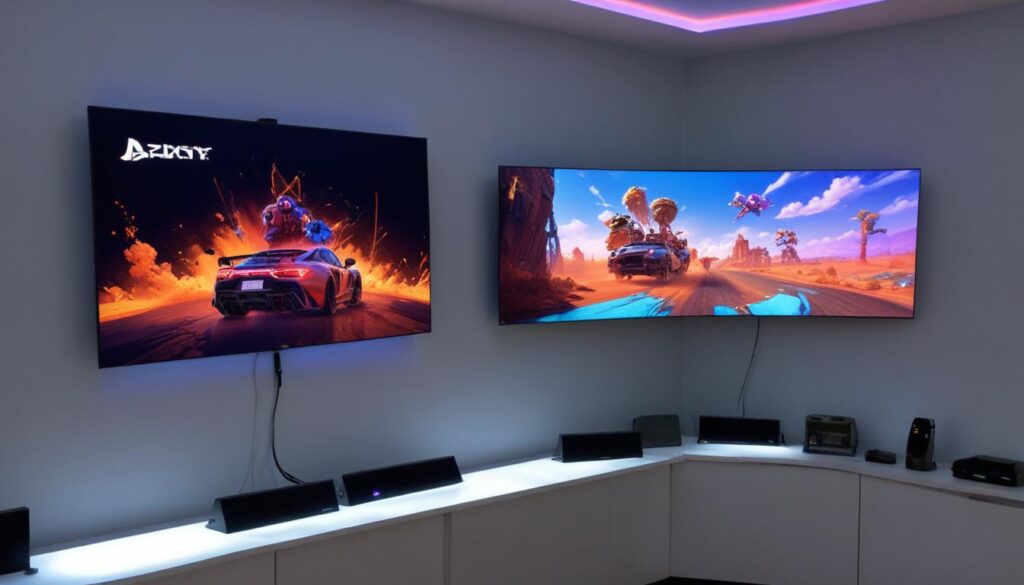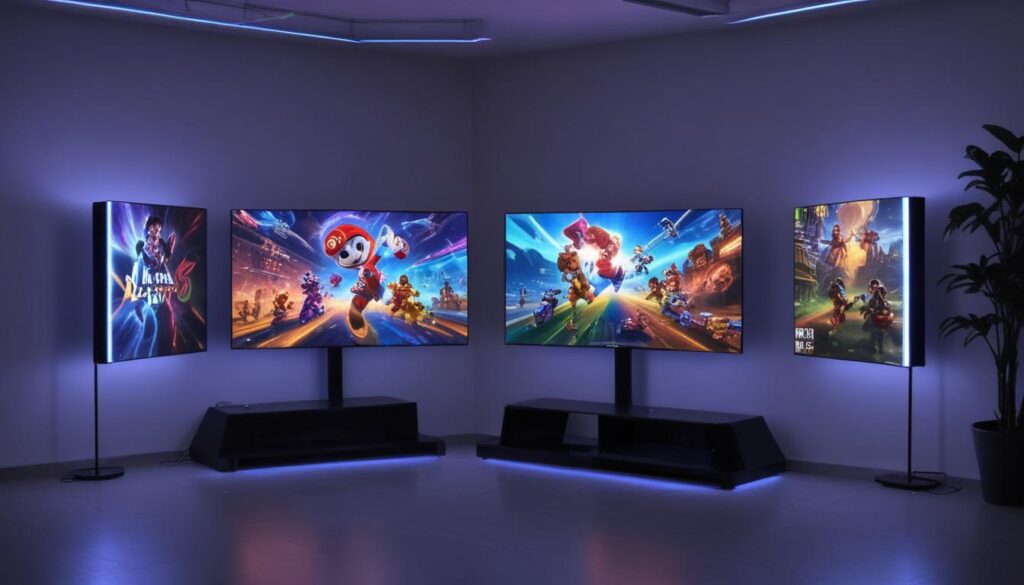Introduction
The problem of many PlayStation 5 and Xbox Series X/S owners is the lack of a suitable TV capable of revealing the full power and capabilities of the console. To choose a good model, you need to understand the new console technologies and the characteristics of the screens themselves. We will help with this.
What are the advantages of PlayStation 5 and Xbox Series X/S
What’s new in these consoles and why your old TV might not be suitable? Let’s highlight the main features.
Resolution up to 8K
The next-gen PlayStation 5 and Xbox Series X consoles support games with a resolution of up to 7,680 x 4,320 pixels. However, there are few projects with such image clarity yet, so you shouldn’t focus on this bar. And in TVs, 8K resolution is only found in very expensive models with a diagonal of more than 75 inches. In other words, this is a reserve for the future.
Unfortunately, the stripped-down Xbox Series S doesn’t have this feature.
4K 120Hz mode
The PS5 and Xbox Series X are the first consoles to support 4K displays with a refresh rate of 120 Hz (the Series S resolution is limited to 1440p). And this is essentially the gold standard that developers are aiming for. However, such a picture greatly increases the load on the device, so for now many games have to sacrifice image quality for the sake of smoothness. That is, you often have to choose between conditional 4K / 60 Hz or FHD / 120 Hz.

HDR support
HDR (High Dynamic Range) technology provides an extended dynamic range. With it, the video signal contains much more information about brightness and color for each pixel. This allows you to transmit a rich image with a richer palette on the screen – bright sunsets, rich sea surface, spectacular backlight and all that.
VRR support
Adaptive refresh rate, or Variable refresh rate, solves the problem of “tearing,” when the frame rate on the screen does not match the output frame rate of the graphics processor. Without VRR, the picture can break, as if some connecting elements fell out of the chain. For the action genre, this will be especially critical.
ALLM Support
Auto Low Latency Mode is designed to detect the connection of the console to the TV and automatically switch it to game mode. This allows you to reduce the delay between input from the controller and the corresponding action. Like VRR, the technology is implemented on the basis of HDMI 2.1.
What to Look for When Choosing a TV for PS5 and Xbox Series X/S Gaming
Not only the above-mentioned capabilities are important, but also a number of basic characteristics of screens, where there are also many pitfalls.
Resolution and screen size
Everything is quite simple here: resolution is the number of pixels on the TV matrix. The more pixels, the sharper and more detailed the picture will be. When choosing a TV for PlayStation 5 and Xbox Series X, look exclusively for 4K models, also known as UltraHD. In the case of Xbox Series S, even FHD will do on a small budget (devices with 1440p are not available for sale).
The choice of diagonal depends on the location of the TV, the size of the room and your habits in general. Roughly speaking, the larger the screen, the further away from it you will have to sit – so as not to shake your head once again and not to see the notorious “grain” of pixels.
To find out the minimum recommended distance to the screen, you need to multiply its diagonal by 1.2. For example, if you have a 50-inch TV, you need to sit 60 inches, or 1.5 m, away from it. Accordingly, for 55 inches it is 1.7 m, for 65 – 2 m, and for 75 – 2.3 m.

Matrix type
Let’s look at the most common options.
IPS . The most popular and cheapest LED matrix. It has good color rendering and contrast up to 1,500:1, but there is no rich black, so backlighting may be visible in dark scenes. Viewing angles are good, and response time is average.
VA . The LED option is more expensive, but has a more contrasting picture and deep black. The response time can be both higher and lower than that of IPS, but the viewing angles and color rendering are usually slightly worse.
QLED. Matrix technology built on quantum dots with backlighting. They provide a very bright and rich image with good viewing angles, as well as correct white and black. But, as in IPS, backlighting may appear in dark scenes.
OLED . A matrix based on organic dots that do not need backlighting – they glow on their own. This means that such a panel has the highest contrast and infinitely black color. The response speed is instantaneous, and the brightness and viewing angles are better than IPS. This is an absolute top, but at the price of an airplane wing.
There are also other matrices that are found only in certain TV lines. For example, NanoCell from LG or Triluminos from Sony – both are based on quantum dots and do not have fundamental differences from QLED.
Matrix backlight type
Backlighting is not relevant for OLED, but for other matrices this point is important, as it is directly related to the brightness and color of the TV . Here are the types of LED backlighting:
Edge LED — literally backlighting along the edges. In this design, the LEDs are distributed along the matrix contour, and its back is covered with a reflective layer. The advantage of this technology is the small thickness of the panel, and the disadvantage is the glare along the edges, which is clearly visible in dark scenes.

